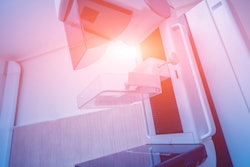
Most women in a recent Dutch survey indicated they weren't comfortable yet with only an artificial intelligence (AI) algorithm interpreting their screening mammograms, preferring AI be used instead as a second reader, according to research published online on 12 October in the Journal of the American College of Radiology.
A team of researchers led by Yfke Ongena, PhD, of the University of Groningen in the Netherlands surveyed over 900 Dutch women to gauge their attitudes on using AI for interpretation of screening mammograms. They found that over 75% of women didn't approve of standalone use of AI without a radiologist.
"Despite recent breakthroughs in the diagnostic performance of AI algorithms for the interpretation of screening mammograms, the general population currently does not support a fully independent use of such systems without the involvement of a radiologist," the authors wrote. "The combination of a radiologist as a first reader and an AI system as a second reader in a breast cancer screening program finds most support at present."
In the Netherlands, women ages 50 to 75 are invited biennially to receive a screening mammography. These exams are read independently by two radiologists, with a third radiologist getting involved in case of discrepancies. In their study, the researchers sought to ascertain the view of the Dutch population on applying AI in mammography screening programs.
A total of 922 women ages 16 to 75 answered a national survey carried out in April 2020. Of these respondents, 77.8% agreed or strongly agreed that it's necessary for a radiologist to also take a look at the study when a computer examines a mammogram.
"These findings are somewhat surprising, because recent work has shown AI to be of great promise for mammography screening, even outperforming radiologists, as was also published in the lay press," they wrote. "Therefore, from the population's perspective, it is too premature to leave the interpretation of screening mammograms completely up to independently operating AI algorithms."
Utilizing AI as a second reader generated the most support, with 37.6% of respondents agreeing that AI should be used to check the judgment of the radiologist. An additional 37.1% neither agreed nor disagreed with the use of AI as a second reader.
In particular, the women who were less supportive of independent AI also had the following opinions:
- They thought AI was less efficient.
- They had a more negative view of AI in medicine.
- They had a lower level of education.
- They valued personal interaction in discussing radiology results.
"Improved information supply and education about the development, possibilities, and limitations of AI algorithms in screening mammography may potentially overcome some of the perceived obstacles and increase acceptance of this new technique in clinical practice," the authors wrote.
In other findings, 44.6% of the women neither agreed nor disagreed that the developer of the computer program would be responsible for an error. What's more, 39.2% of the women neither agreed nor disagreed that the radiologist would be responsible in the event of an AI error.
"Accountability in case of AI-related diagnostic errors in screening mammography is still an unresolved conundrum," they wrote.



















